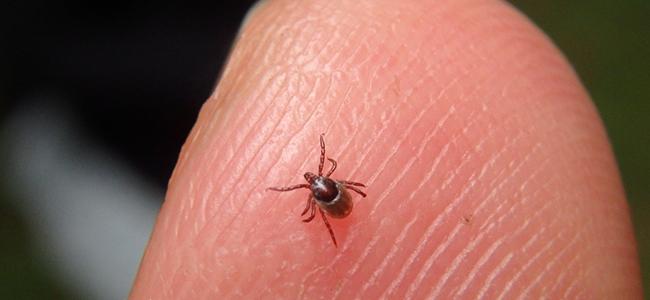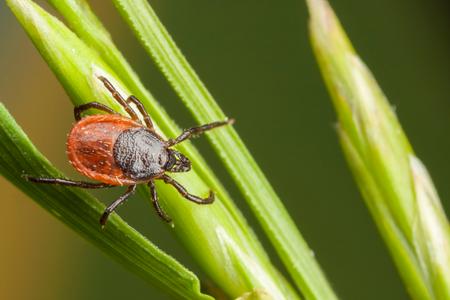
The Best Tick Control For Maryland Properties
10/01/2021
In Maryland, we have some of the most enjoyable weather (for most of the year) for playing out in the yard and enjoying time with our pets. Unfortu...
READ MORE >

Thirty years ago, you didn’t hear much, if anything, about ticks. Kids went about their springs, summers, and falls dashing through the woods and jumping in leaf piles with nary a worry. Unfortunately, when it comes to ticks, a lot has changed in the past three decades. Tick populations seem to grow with every passing year and so too does the threat of contracting a tick-borne disease.
If you want to learn more about ticks, the threats they cause, and how to maintain effective tick control around your Baltimore home, look no further than our complete guide. Here you’ll find all the information you need to protect yourself and your family from these harmful pests.
Ticks are small, parasitic pests. As part of the arachnid family, they have four sets of paired, jointed legs and lack the antennae you find on insects. There are 90 different species of ticks found in the US, but far fewer are common in Baltimore. The six that you are most likely to encounter in Maryland are the blacklegged deer tick, American dog tick, brown dog tick, Lone Star tick, Gulf Coast tick, and Asian longhorned tick.
While all ticks are similar in appearance, they do have some small differences that help differentiate them from one another. Their similarities are in their flat, oval-shaped bodies that swell when engorged after a feeding, their legs, and their segmented bodies. Their main differences are in their size and coloring:
The tick life cycle can vary in length depending on the species of tick, ranging from a few months to up to two or three years. However, all tick species follow the same four stages of development. Ticks begin as eggs that then hatch into six-legged larvae. After the larval stage, ticks become eight-legged nymphs. The final stage is the adult stage.
Each stage of development requires that the tick have a blood meal to survive and move onto the next stage. Adult females require a blood meal before being able to lay eggs.
To complete a blood meal, ticks go through a process that takes several days. It can take anywhere from ten minutes to a few hours for a tick to prepare to eat. It cuts into the skin of its host and inserts a feeding tube inside. The saliva of ticks has anesthetic properties that can stop the host from feeling the intrusion, and since ticks often find a sheltered area in which to feed, a tick can go unnoticed the entire time they are attached to the host. It can take several days for a tick to complete a meal as it slowly feeds before removing its feeding tube and dropping off the host.
As parasitic pests, ticks require a host to supply them with the blood meal they need to survive. Most ticks choose different types of hosts in each stage of development and will feed on mammals, birds, reptiles, and amphibians.
Ticks become dangerous when they pick up diseases during their feedings. For instance, if a tick feeds on an infected mouse during the larval stage, then attaches itself to a human for a blood meal during the nymph stage, it can transmit that disease to the human host through infected saliva.
Ticks are known to spread many serious, chronic, and sometimes fatal illnesses. The types of diseases you can get from a tick vary with the type of tick, but include all of the following:
Many of these illnesses are difficult to diagnose because of their general flu-like symptoms in the early stages. If you did not see a tick on you, you may not suspect a tick-borne illness and assume you’ve just caught a short-term virus. However, if not treated, some of these illnesses can cause a variety of serious long term problems. In extreme cases, they can even lead to death.
Because ticks can easily get on a host without being noticed, it’s imperative that you take steps to avoid getting ticks on you any time you go outdoors. Taking preventative measures is the best way to avoid a tick-borne illness. If a tick doesn’t have a chance to embed itself into your skin, it won’t be able to transmit a disease to you.
One way to reduce your risk of getting a tick on you is to keep as much skin covered as possible. Wear long pants and long-sleeved shirts. Tuck your shirt into your pants and your pants into your socks to close any gaps between articles of clothing where ticks could sneak underneath and onto your skin.
Wearing light-colored clothes can help you easily identify when a tick gets on you, allowing you to remove it before it has a chance to bite you.
In Baltimore's heat, wearing full-length clothing isn’t always practical. In these instances, it’s smart to use an insect repellent that contains DEET, permethrin, or picaridin. If you don’t want to spray it directly on your skin, spray it on your clothing and shoes.
Avoiding outdoor areas where ticks are most likely to be is a smart way to avoid ticks while enjoying the great outdoors. Areas that commonly have a lot of tick activity include wooded areas, areas with tall grass, and areas with a lot of leaf litter.
Finally, it’s important to check yourself over for ticks every time you go outside. Carefully inspect your body for even the smallest dark spots, as ticks in the larval and nymph stage can be extremely tiny. Ticks tend to prefer warm, moist areas, such as the armpits, but they are also often found behind the ears or on the scalp. In all reality, though they have their preferences, ticks will latch onto any part of the body.
While knowing some preventative measures to take when you’re going outdoors is helpful, if you have a tick problem on your own property, you’re going to have reason to be concerned every time you step outside. Knowing how to reduce the risk of a tick problem on your Baltimore property is important for your health and your peace of mind.First, knowing where ticks tend to spend their time when they’re on the ground can help you reduce these types of areas on your property. When ticks are found on people’s property, it’s usually in the transitional zone between their yard and the woods or fields beyond. By separating these areas with stones or even a fence, you can help prevent ticks from entering your lawn.
Ticks also tend to spend time in tall grass and leaf litter. Make sure to keep your lawn trimmed, and clean up any debris that collects there regularly.
If you’re serious about keeping ticks off your Baltimore property, you’re going to want to keep away the animals that carry the ticks to your property. Although ticks are fairly fast walkers, they’re not going to travel miles and miles to get to your house. Instead, the way that most ticks end up on your property is by riding in on their hosts, then dropping off them onto your lawn or in the woods nearby.
To keep these ticks away, you need to make your property unappealing to wildlife:
While all of the tips mentioned above can help in your fight against ticks, the most effective way to keep ticks under control is to enlist help from the professionals. At American Pest, our service professionals are specially-trained in the biology and habits of ticks. When you choose us to help you, we’ll combine our knowledge with a thorough inspection of your property. This helps us identify where ticks are harboring to provide you with a tick control plan designed with your Baltimore property in mind.
With ongoing tick treatments, you can rest assured that any tick problem around your property is under control all season long. The serious threat of illness caused by ticks is not a matter to take lightly, and with American Pest, you don’t have to worry. For advice about pest control in Baltimore, or to schedule a treatment, contact us today.

10/01/2021
In Maryland, we have some of the most enjoyable weather (for most of the year) for playing out in the yard and enjoying time with our pets. Unfortu...
READ MORE >

08/23/2021
Ticks are considered to be some of the most dangerous arachnids around. Not only are they famous for biting people, pets, and wildlife creatures, b...
READ MORE >

07/15/2021
Each year, tick populations are on the rise. This is due to a multitude of factors, including climate change and increased tick habitat. Frederick ...
READ MORE >

06/22/2021
It's Pest Prime ...
READ MORE >

Protect your home and family from nuisance and potentially damaging pests with a Preferred Care home pest control plan. Starting at $49/month

Don't let the bed bugs bite a second longer. Contact American Pest for the most comprehensive bed bug control in the industry. Learn More

Our certified rodent control pros will put an end to your frustration by getting rid of rats and mice inside your home. Learn More

Say goodbye to wood-destroying termites in your home when you contact American Pest for expert termite control. Learn More

Trust American Pest to deliver professional backyard tick control services that are guaranteed to get results. Learn More

Don't spend the warm-weather season indoors, find out how American Pest's professional treatments get rid of mosquitoes. Learn More
Fill out the form and recieve feedback in less than 5 minutes. For immediate service please call.